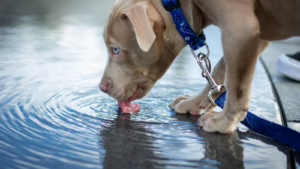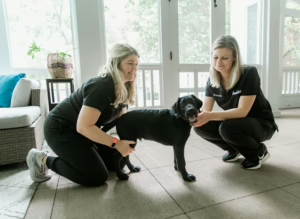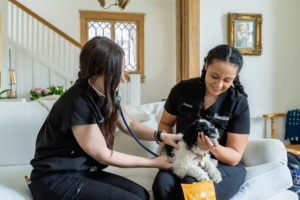To better understand storm phobia in your dog or cat, ReadiVet Chief Medical Offer Dr. Ben Clemmett explains the symptoms of storm anxiety, and how to help your best friend weather a storm.
When In Doubt, Consult Your Veterinarian
As a veterinarian, we’re here to help consult you on the best way to calm your pet’s fear of thunderstorms. We know our patients well and are always willing to provide personalized advice. We can work with you 1:1 to find an OTC or prescription anti-anxiety medication (like Trazadone) that will help any dog or cat with severe or persistent storm anxiety.
Symptoms of Storm Anxiety and Noise Phobia
Storm anxiety, or thunderstorm phobia, can be especially challenging in the spring and summer when pop-up storms are frequent. Noise phobias represent the most prevalent behavioral problem in dogs. In fact, studies indicate between a quarter and half of all dogs are affected. Fireworks are the most common trigger, followed by thunder. So it’s common that the fear of thunder, lightning, and heavy rain can all trigger a pet’s anxiety and result in unusual behaviors including:
- Pacing or restlessness
- Panting or drooling
- Trembling or shaking
- Hiding or cowering
- Destructive behavior
- Desire to be close to their person or another animal
So, how do you calm your dog or cat during a thunderstorm?
Fortunately, there are tools, remedies and medications that your veterinarian can prescribe or recommend to help calm your pet who is afraid of thunderstorms and prevent these anxieties. But first and foremost, the best thing you can do to influence the comfort level of your pet is to stay calm yourself and make sure they have a safe space, as this is a psychological defense for both dogs and cats.
Distraction and Desensitization
- Distract your pet from scary sounds outside with positive sounds, movement, and play. This includes playing white noise or calming music, interactive toys, indoor fetch, tug, or a high value treat. Keeping your pet physically and mentally distracted helps divert their attention away from a thunderstorm.
- Desensitize your pet to the sound of thunder and by playing thunderstorm sounds at a low volume at a time when your pet is happy and calm. Gradually increase the volume over time, helping to lessen your pet’s anxiety to storms. Pair this behavioral therapy with a high-value treat or lots of attention to help them build positive associations.
Helpful Remedies
- ThunderShirts® have a calming effect thanks to gentle, constant pressure, just like swaddling a baby. They make these anxiety wraps for cats too, and I have found they work well for many of our pet patients.
- Try a pheromone. Available as a mist, spray or a special collar, these are species-specific chemical signals that send comforting messages and support calmness. I recommend Adaptil collars and diffusers for dogs, or Feliway diffusers, sprays, and wipes for cats.
- Coax them to sleep with Benadryl or Melatonin. These both have a sedative effect that will help an anxious pet rest. For both cats and dogs, Benadryl is dosed at 1mg/pound and Melatonin is dosed at 1mg/20 pounds. You’re safe to use both these products in a pinch, just make sure they do NOT contain xylitol.
- Use supplements. Many helpful supplements are available without a prescription. As per most behavioral issues, each individual pet responds differently to different supplements and medications, so one pet may have a great response to a product and the next pet may not be helped much at all. Prescription medications tend to work better than supplements in most cases, but supplements alone can help many pets. My recommendation is Zylkene, a supplement that contains a hydrolyzed milk protein called casein, which helps calm your pet during a thunderstorm.
- To CBD or not to CBD? CBD can reduce anxiety and encourage a sense of calm in both people and pets, but there’s a lack of data as to whether it’s safe in combination with other medications and to how well it works. Since pets are more sensitive to CBD, make sure to choose a CBD product designed for pets and always follow the dosage instructions.
Thunderstorm anxiety and noise phobias can be distressing for both a pet and their people. By recognizing the signs of anxiety in your cat or dog, you can prepare for that pop-up thunderstorm with effective remedies that alleviate your pet’s stress.




